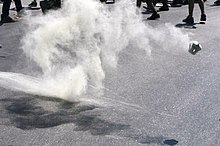Tear gas


Tear gas, formally known as a lachrymatory agent or lachrymator (from lacrima meaning "tear" in Latin), is a non-lethal chemical weapon that stimulates the corneal nerves in the eyes to cause tears, pain, and even blindness. Common lachrymators include OC, CS, CR, CN (phenyacyl chloride), nonivamide, bromoacetone, xylyl bromide and syn-propanethial-S-oxide (from onions).
Effects and use
Tear gas works by irritating mucous membranes in the eyes, nose, mouth and lungs, and causes crying, sneezing, coughing, difficulty breathing, pain in the eyes, temporary blindness, etc. Lachrymators are thought to act by attacking sulphydryl functional groups in enzymes. One of the most probable protein targets is the TRPA1 ion channel that is expressed in sensory nerves (trigeminal nerve) of the eyes, nose and mouth. First used in 1914, xylyl bromide was a popular tearing agent since it was easily brewed.
Lachrymatory agents are commonly used as riot control and chemical warfare agents. During World War I, more toxic lachrymatory agents were used. Certain lachrymatory agents are often used by police to force compliance, most notably tear gas. In some countries (e.g., Finland, Australia, and the United States), another issued substance is mace, which is used as a personal attack repellent.
Military use of tear gas (as all other chemical weapons) is prohibited by various international treaties. Police use is not banned in the same manner.
See also
References
Further reading
- BBC information about CS gas
- How to combat CS gas at eco-action.org
- Brone et al (2008)
